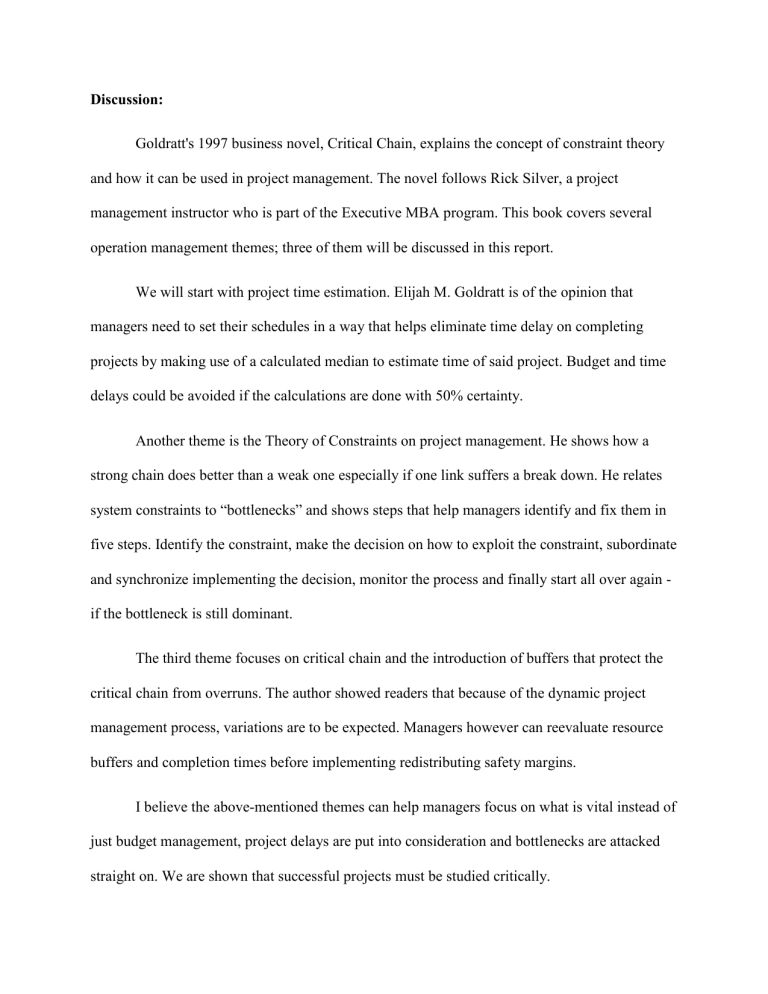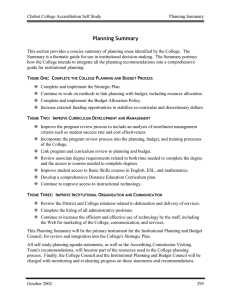
Discussion: Goldratt's 1997 business novel, Critical Chain, explains the concept of constraint theory and how it can be used in project management. The novel follows Rick Silver, a project management instructor who is part of the Executive MBA program. This book covers several operation management themes; three of them will be discussed in this report. We will start with project time estimation. Elijah M. Goldratt is of the opinion that managers need to set their schedules in a way that helps eliminate time delay on completing projects by making use of a calculated median to estimate time of said project. Budget and time delays could be avoided if the calculations are done with 50% certainty. Another theme is the Theory of Constraints on project management. He shows how a strong chain does better than a weak one especially if one link suffers a break down. He relates system constraints to “bottlenecks” and shows steps that help managers identify and fix them in five steps. Identify the constraint, make the decision on how to exploit the constraint, subordinate and synchronize implementing the decision, monitor the process and finally start all over again if the bottleneck is still dominant. The third theme focuses on critical chain and the introduction of buffers that protect the critical chain from overruns. The author showed readers that because of the dynamic project management process, variations are to be expected. Managers however can reevaluate resource buffers and completion times before implementing redistributing safety margins. I believe the above-mentioned themes can help managers focus on what is vital instead of just budget management, project delays are put into consideration and bottlenecks are attacked straight on. We are shown that successful projects must be studied critically. Application: A production and distribution company I previously worked with, CHF Heron Nigeria Limited, would be used in this report to demonstrate the application of these themes. This company focused on obtaining raw materials, processing these materials with the use of machinery, repackaging and sales. The first applicable theme is project time estimation. When determining how long it would take to complete a project, we often introduce safety margins in case of delays. It was estimated that one product or project takes 5 days to complete, with ample margin for all types of uncertainty and delay. However, with the introduction of Goldratt's concept of time estimation, the estimate will drop somewhere in two days. The redefined estimates will help reduce activity-related contingencies and create more accurate schedules. This will at least help the company focus on getting projects done on time without any tension, and at most they would finish in 3 days. The time saved is spent working and completing new projects. In applying the theory of constraints, in the company previously mentioned, we would be able to tackle a huge undermined challenge of machine break down that occurs after some production time. Most times (as was the case with this company) constraints like these are normalized and not properly investigated without the realization that they can be intentionally dealt with to improve outcomes. This theme would guide to the investigation of this issue with the intention of finding out the specific time and processes that lead to the break down. Next, we would use the information we found to determine where the problem lies. This information would guide us to draft out maintenance solutions where it is required and invest in more machinery if necessary. After these, the company would need to put these solutions into effect and monitor the changes the decisions have on the outcomes. Finally, the process would be repeated until the constraint is completely eliminated and production returns to its peak. The final theme focuses on the placement of buffers that are in charge of protecting the critical chain. This theme shows how management is a complicated process and Project management is not an exception. Uncertainties are often responsible for ruining the expected smooth process and this causes changes that affect the use of tools, resources and completion times. This situation should lead managers to introducing new approaches. The critical chain concept shows that instead of putting all the dice on getting work done or completing an activity, Managers need to include adjusted safety times and resource allocation that fit a specific situation. Activities involved in completing a said project should be themed critical in all cases. The buffer concept aligns activities with late finish dates and emphasizes on the need to remove resource constraints. Priority is given to critical chain activities while assigning resources. Feeding buffers can be added to noncritical chains to make their durations match the critical chain. The project buffer should be added to the end of the critical chain and before the project end date. Evaluation The book provides principles and solutions that help fix problems associated with scheduling projects. It portrays this information through the eyes of real people and real events. The author stated existing project management difficulties and methods to eliminate them. These principles help managers get project done on time, utilize their resources and make provision for new approaches. The organization of this a novel is like business textbook. Professor Rick Silver and three of his students were the central protagonists in the story, they have well defined (step-by-step) goals to cut down the time needed to complete a project some of which had diagrammatic methods. I would recommend this book because it is easy to read. Its novelist nature allows readers to flow with its plot while grasping the knowledge it teaches. Critical Chain in general portrays an excellent illustration of how a new idea can be captivating.


